William Blake’s Demonic Red Dragon
William Blake was one of the most important poets, engravers, and artists of the Romantic Age. He is considered amongst the greatest of the English poets – along with the likes of Keats, Shelley, Byron, and Coleridge. But he died penniless, scorned by his contemporaries and the art establishment. Blake was undoubtedly unconventional and provocative. Here, we take a look at one of his most famous works: The Great Red Dragon and the Woman Clothed in Sun.
Summary
Let’s take a look at William Blake’s iconic masterpiece The Great Red Dragon and the Woman Clothed in Sun through the lens of Blake’s unusual and inspiring life.
Apocalyptic End Times
Between 1805 and 1810 William Blake made over 100 ink and watercolor Bible illustrations, commissioned by one of his few patrons, Thomas Butts. The Great Red Dragon images accompany the Book of Revelations, a biblical warning to Christians of the fearful consequences of loss of faith.
Christians believe that John the Theologian had been exiled to the Greek island of Patmos in the Aegean Sea. While living in a grotto called the Cave of the Apocalypse, he saw visions of the fate of mankind. These were recorded as Revelations. The dragon is Satan. His mission is to torture and destroy followers of the Christian faith.
And behold a great red dragon, having seven heads and ten horns, and seven crowns upon his heads. And his tail drew the third part of the stars of heaven, and did cast them to the earth.
The Bible
Revelations 12:3-4.
The Great Red Dragon
In William Blake’s The Great Red Dragon and Woman Clothed in Sun, the dragon descends on the woman, he intends to exact revenge on her for birthing a child who will spread the word of God. In this version, the immense dragon takes up almost the whole image. His back is towards us, showing his magnificently muscular tail. His sweeping wings fill the space, too huge to be contained by the edges of the paper. He is fierce and frightening. The woman lies beneath him, exposed and vulnerable, praying.
And the tail of the great red dragon drew the third part of the stars of heaven and did cast them to the earth. And the dragon stood before the woman which was ready to be delivered for to devour her child as soon as it was born
William Blake
Inscription on the watercolor The Great Red Dragon and the Woman Clothed in Sun, 1803-1805, Brooklyn Museum, New York, NY, USA.
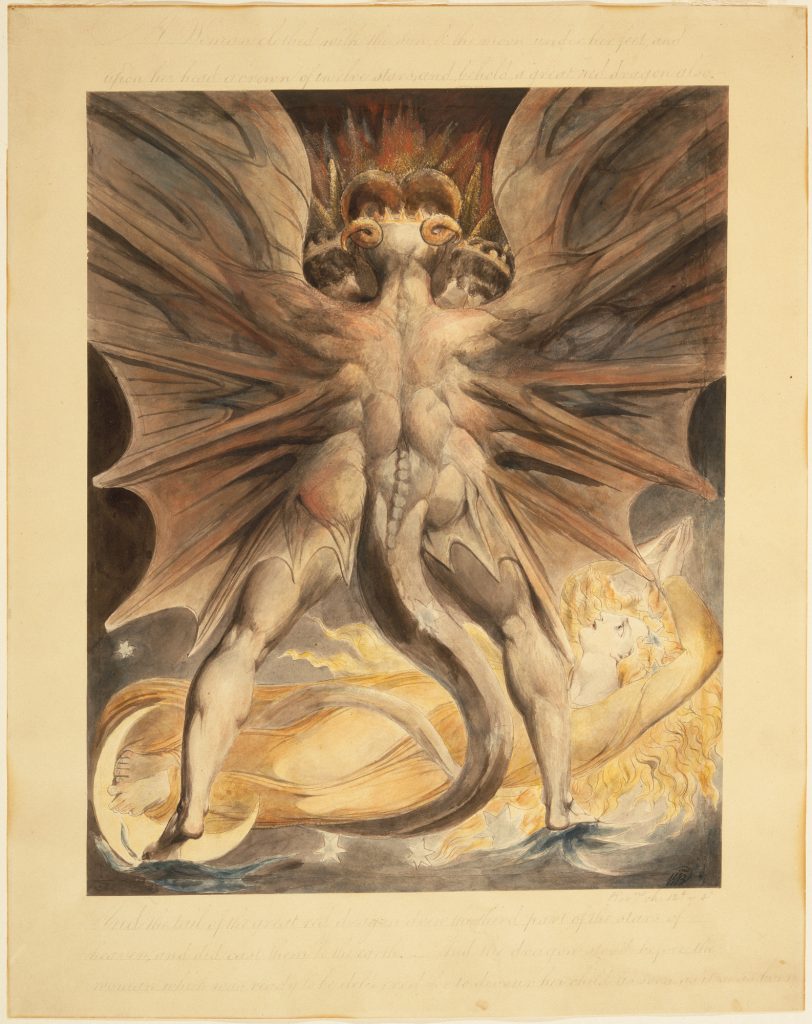
William Blake, The Great Red Dragon and the Woman Clothed in Sun, 1803-1805, Brooklyn Museum, New York, NY, USA.
The Duality of Life
In another version, the woman’s figure is bathed in brilliant sunshine, the light reflects in the crescent moon which holds her. She wears a crown of 12 stars. Above, the dragon’s wings beat the air. The creature is surrounded by darkness.
Below them both, waters rise ominously. But now, she also has wings and seems to be reaching for the sky. The two figures mirror and reflect each other. They are the essential duality – light and dark existing together. Is Blake exhorting us to engage with our own duality and live with our shadow side?
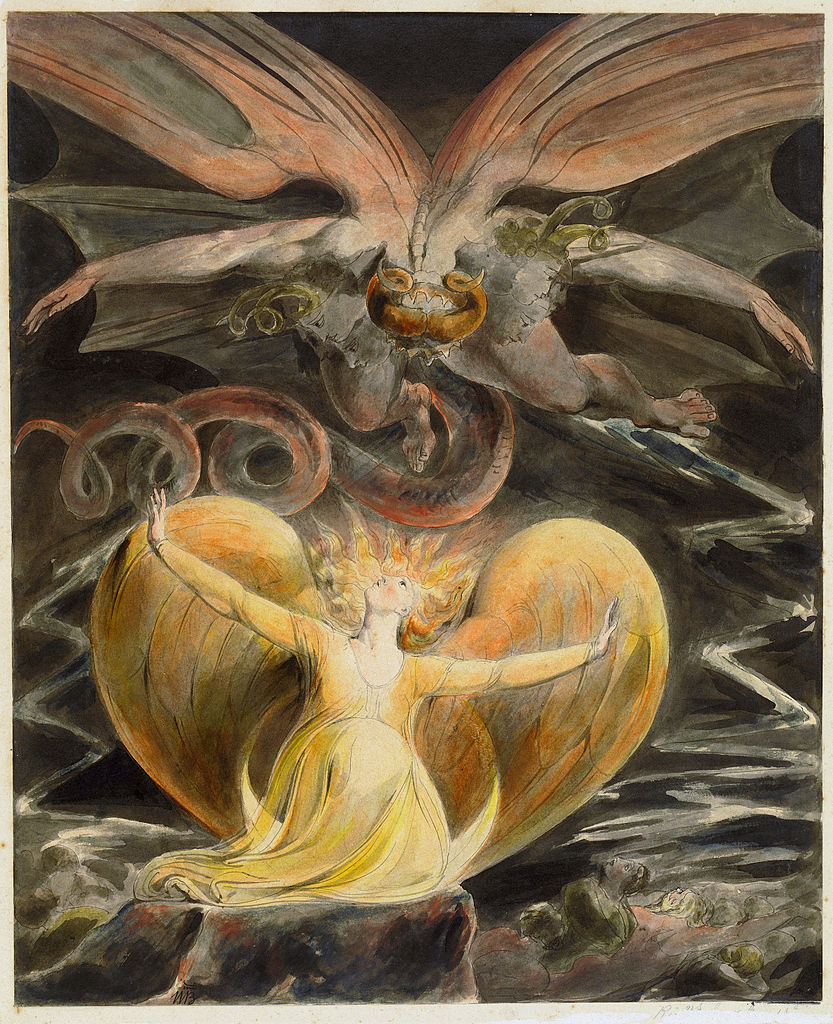
William Blake, The Great Red Dragon and the Woman Clothed in Sun, 1805, National Gallery of Art, Washington, DC, USA.
Childhood
William Blake was an unconventional child. Educated at home in London, he had mystical visions from the age of four and saw angels in the trees in the street. He even met Satan on a staircase. His parents enrolled their son in drawing school at age 10, and he was later apprenticed to an engraver, working in a print shop. This could have been a perfectly decent and productive career, but Blake wanted more, much more.
A great reader, he was writing poetry from childhood. A short stint at the Royal Academy of Art was stifling – he wanted to combine his art, his writing, his philosophy, and his poetry freely and without compromise. He was multi-media before anyone even knew what the word might mean.
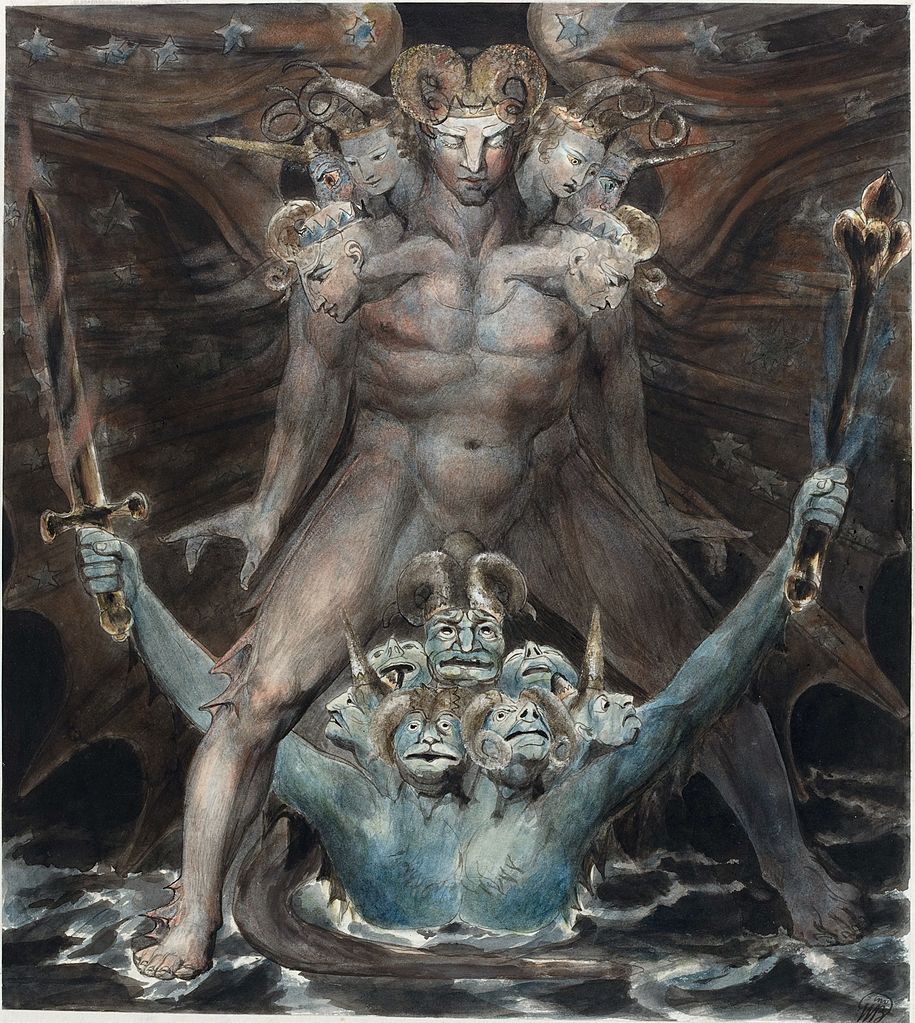
William Blake, The Great Red Dragon and the Beast From the Sea, 1805, National Gallery of Art, Washington, DC, USA.
Printing Press
Illuminated poetry was Blake’s great love, and eventually, he set up his own printing shop, self-publishing his works. His beloved dead brother appeared to him with instructions on a new printing idea. From this vision, Blake developed a process of relief etching that allowed him to combine both etching and text on the same printing plate – suddenly he had complete control over how his art was produced and presented.
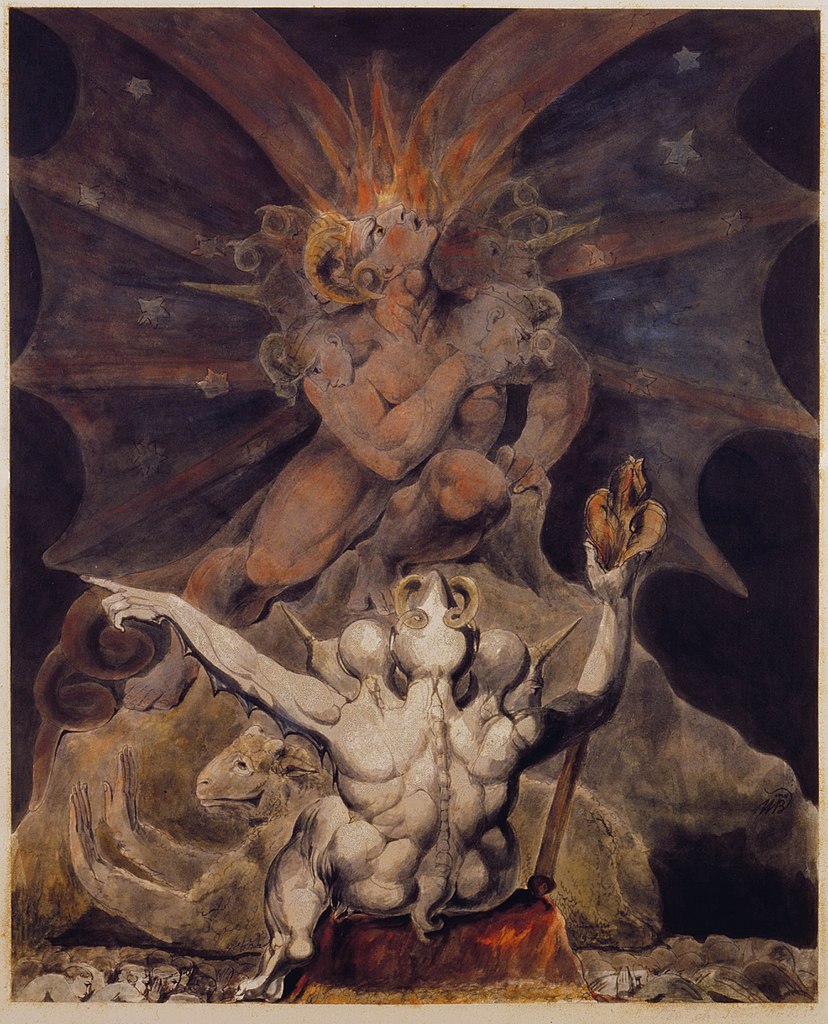
William Blake, The Number of the Beast is 666, 1805, Rosenbach Museum, Philadelphia, PA, USA.
Immense Change
Blake saw the world as a cosmic battle between good and evil. He felt the oppression of centuries of sin. Reality for Blake was a shifting, fantastical universe. The world around him was changing fast, and Blake was unsure about where this was going. Revolutions were raging in France and America. The Industrial Revolution and new technology were sweeping across Britain, creating huge political and social change.
Faith And Sex
An intensely spiritual man, Blake believed that true faith was incompatible with institutionalized religion. He advocated sexual freedom and criticized traditional marriage. His parents were interested in the Moravian and Swedenborg churches, which practiced a Kabbalah-like version of mystical marriage, eroticism, and sacred sexuality.
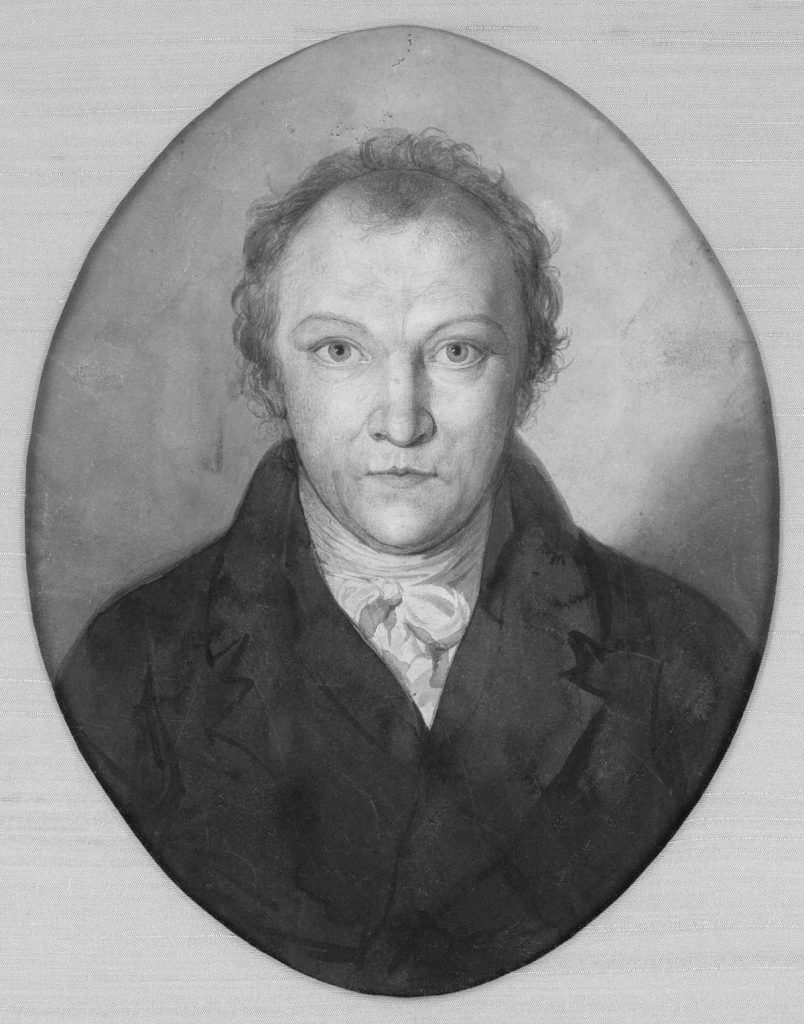
William Blake, Self-portrait, 1802, Tate, London, UK.
High Stakes for the Soul
William Blake was an atypical Christian. He didn’t go to church or follow doctrine. He coined the phrase ‘Nobodaddy’ to ridicule a jealous and dark God who hid from view. Blake fervently believed the human imagination was a divine force, and that creating art was a religious, spiritual act.
The central idea in Western philosophy and religion is that mind and matter are separate things. Blake fundamentally disagreed. His creed was that all the gods, angels, and demons live within humans: “all deities reside within the human breast”. His visions were a gift, and he loved them. Here was an original mind – eccentric and passionate. Everything he painted, he had seen and felt, quite literally.
The imagination is not a state, it is the human existence itself.
William Blake
Alfred Kazin, The Portable Blake, 1979.
Greatest Works
He is probably most famous for A Vision of the Last Judgement; Milton; The Marriage of Heaven and Hell; Songs of Innocence and The Book of Job. He illustrated Dante’s Divine Comedy, and he wrote Jerusalem, which was set to music by the composer Hubert Parry. Often sung as a patriotic hymn by the English, it is ironically about dissent and is a criticism of the establishment.
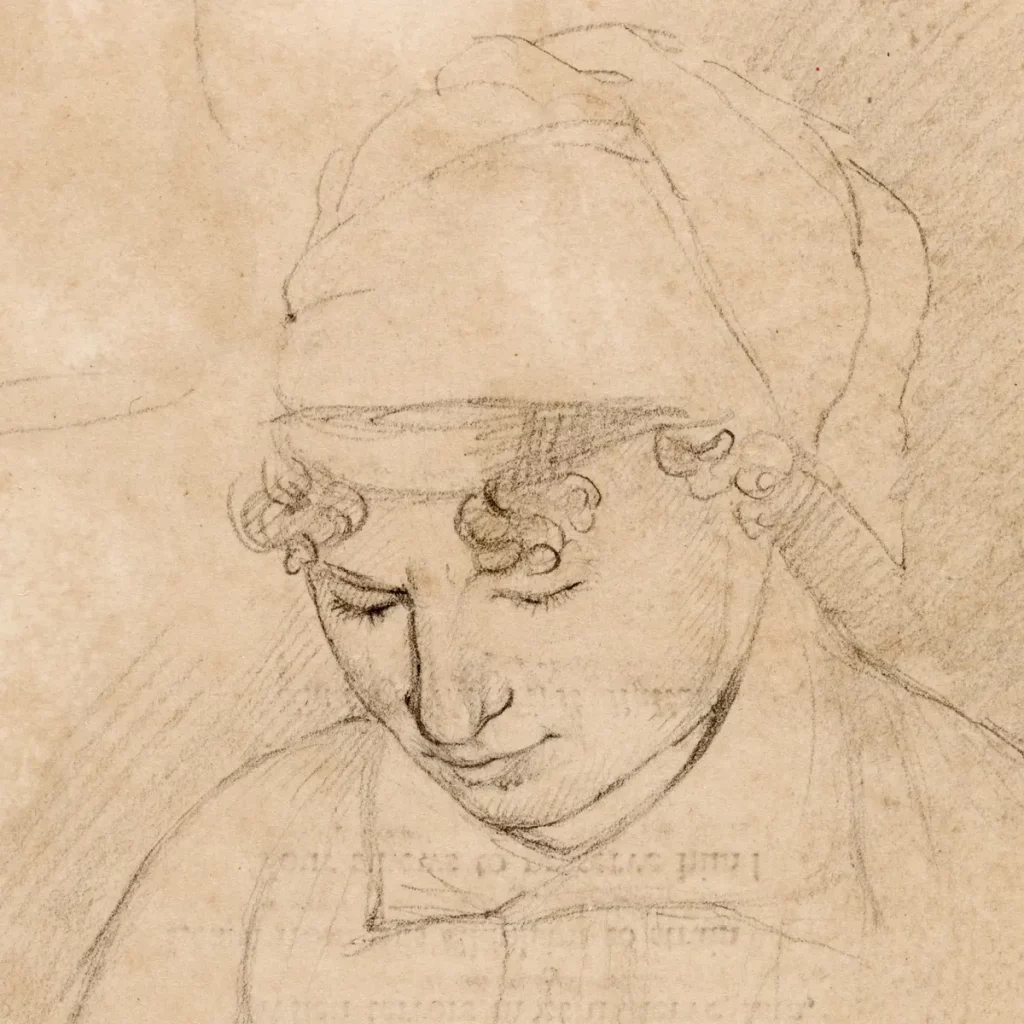
William Blake, Portrait of Catherine Blake (nee Boucher), 1805, Tate, London, UK.
Unconventional
Despite being critical of the bonds of marriage, he wed Catherine Boucher in 1782. That relationship seems to have offered Blake significant security and comfort. Practical and supportive, Boucher was his great love. Blake taught her to read and write, and she also worked alongside him, coloring his prints and working the printing press.
Blake believed life was a complex web of gender and sexuality. His thoughts on women were confusingly modern and regressive all at the same time. He celebrated female sexuality and attacked repression, but still sometimes referred to woman as subordinate to man.
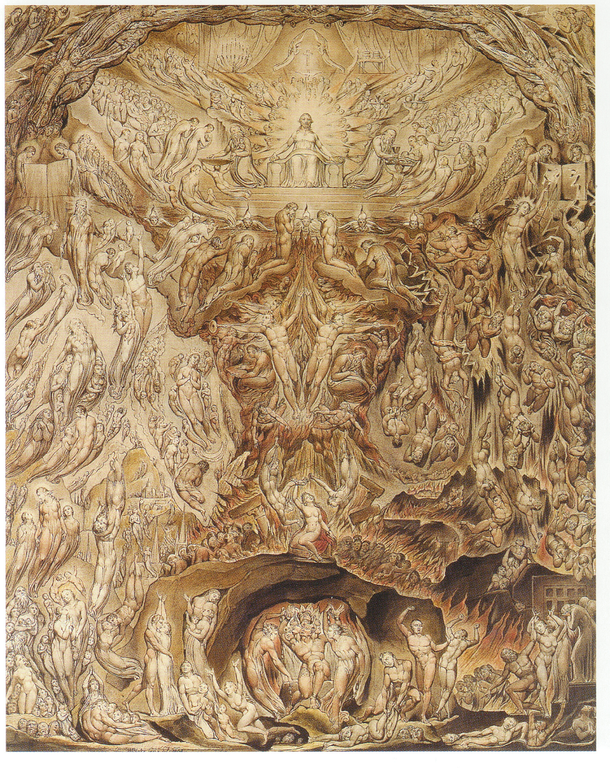
William Blake, The Vision of the Last Judgment, 1808, National Trust, Petworth House, Sussex, UK.
Influences
The Bible, ancient mythology, and the greats of art history were Blake’s inspirations. He adored Dürer, Raphael, and Michelangelo. Consider The Last Judgment by Michelangelo, on the altar wall of the Sistine Chapel. We see sinners condemned to eternal fire, while the faithful join the angels and saints in heaven. Although Blake couldn’t afford to visit the Italian chapel in person, it was certainly an influence.
Shall I call him Artist or Genius—or Mystic—or Madman? Probably he is all.
Henry Crabb Robinson
Diary entry, 10th December 1825, The Henry Crabb Robinson Project.
A Unique Talent
Blake only really became popular as political and social changes moved across Britain and Europe. He was a pacifist, anti-racist, and he deplored child labor. The Pre-Raphaelites were very fond of his radical views, and they played a part in re-discovering his work. He does have his critics to this day, however, who think his creepy, gothic art is only suitable for heavy metal record sleeves or perhaps the cover of a fantasy Tolkein-like book.
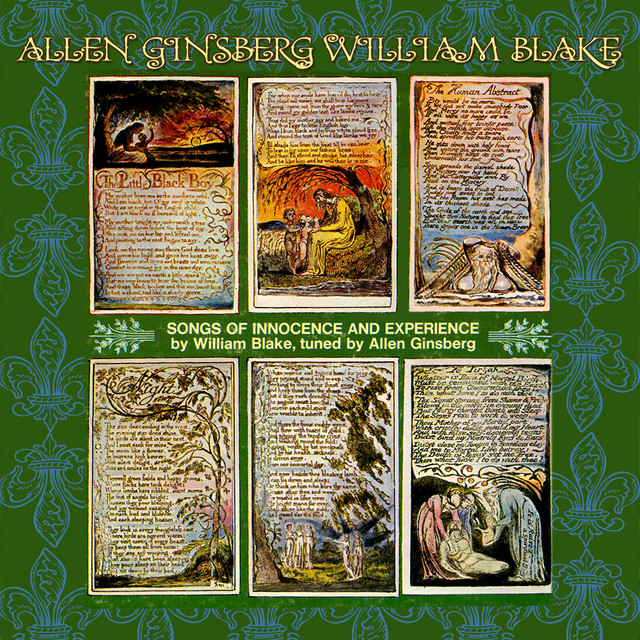
Allen Ginsberg, Songs of Innocence and Experience, 1970. Spotify.
Blake’s Legacy
Abstract Expressionist Jackson Pollock had an illustration by Blake permanently pinned to his studio wall. Bob Dylan and poet Allen Ginsberg collaborated to put two Blake poems to music. Ginsberg said that Blake’s spirit had communicated the musical settings of several poems to him. Phillip Pullman cites Blake as an influence in the His Dark Materials trilogy. V for Vendetta and Watchmen graphic novels by Alan Moore also incorporate Blake’s work.
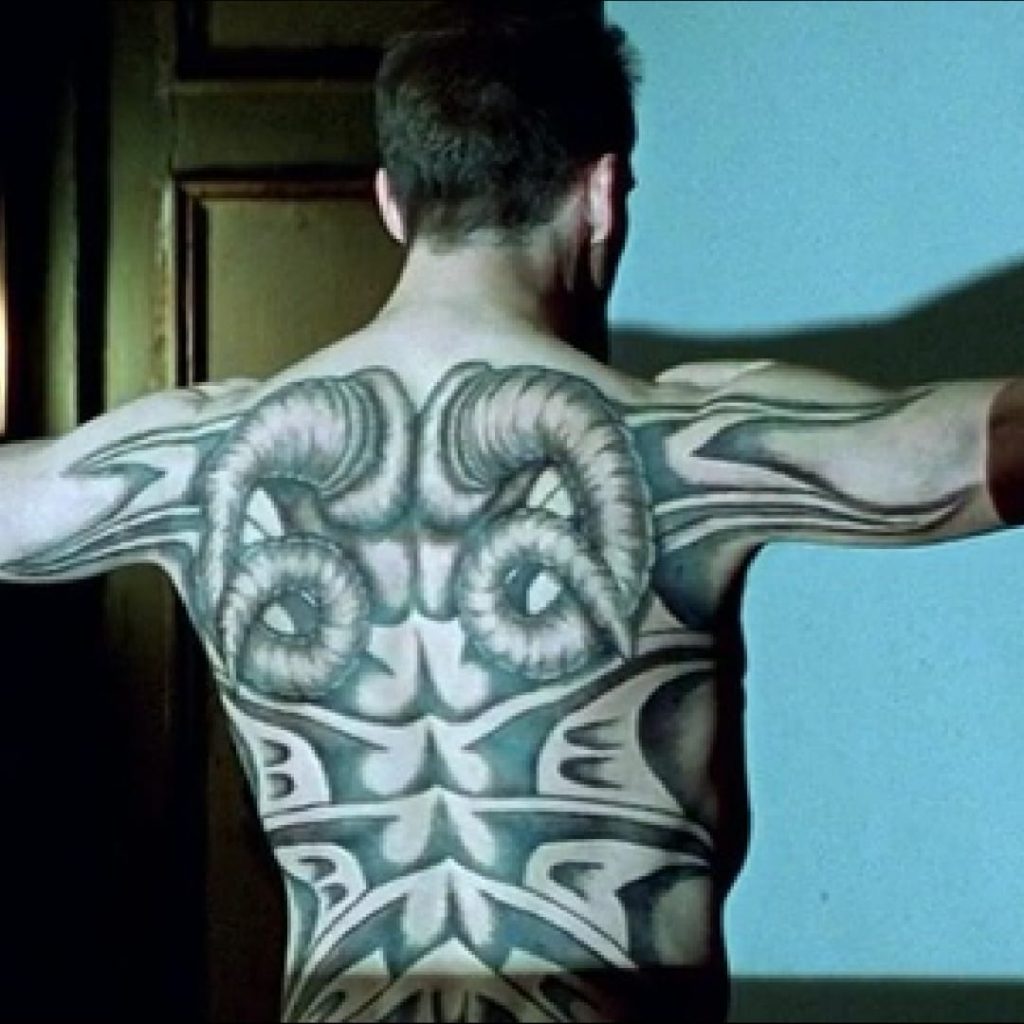
Movie still from Red Dragon, Actor Ralph Fiennes as Francis Dolarhyde with Blake’s Red Dragon tattoo, directed by Brett Ratner, 2002. Tattoodo.com.
Books and Films and Free Love
Novelist Thomas Harris put Blake’s work center stage in his book Red Dragon, about a deranged killer, Francis Dolarhyde who is obsessed with a painting, believing that it communicates with him. Dolarhyde murders entire families to “become” the dragon. He has a huge and striking tattoo of the dragon across his back.
The novel was made into a film of the same name. I’m not sure Blake would have approved. The 1960s postwar generation fell in love with Blake, echoing his ideas of casting off authority and seizing sexual liberation. Aldous Huxley talks of Blake’s doors of perception when he experiments with the drug mescaline. Each generation sees something new in William Blake.
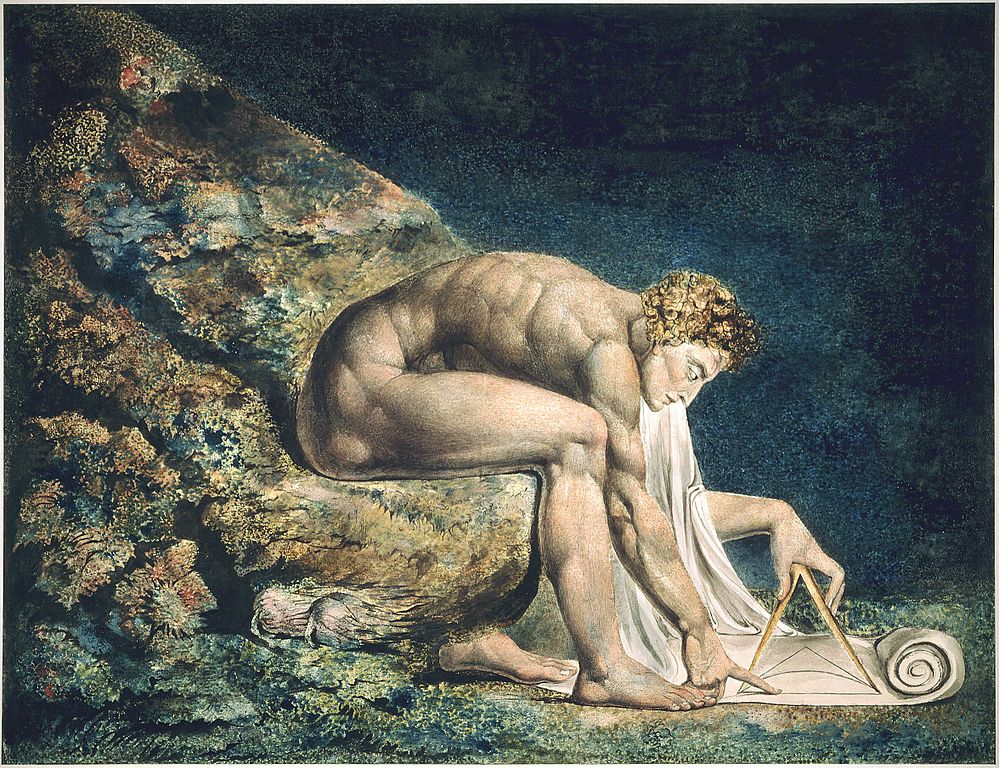
William Blake, Newton, 1795-1805, Tate, London, UK.
Visionary
And what does he offer us today? Did he leave clues for us to follow? I think so. He urges us to use our imagination to change the world for the better, to look for a new worldview. His life is certainly a reminder to appreciate and celebrate those who are not neurotypical.
Blake’s melodramatic and disturbing images encourage us o see the horror, but to have faith in humanity. Blake is railing against ‘outsourcing’ our spiritual and emotional lives to those who claim to know better. He urges us to cast off our “mind-forged manacles”. If we are both angel and demon, then we can choose to do better. His belief in the interconnectedness of all things seems very modern. Redemption is possible, we just have to use our imaginations.
Bibliography
1.
John Higgs, William Blake vs the World, 2021, Orion Publishing.
We love art history and writing about it. Your support helps us to sustain DailyArt Magazine and keep it running.
DailyArt Magazine needs your support. Every contribution, however big or small, is very valuable for our future. Thanks to it, we will be able to sustain and grow the Magazine. Thank you for your help!


